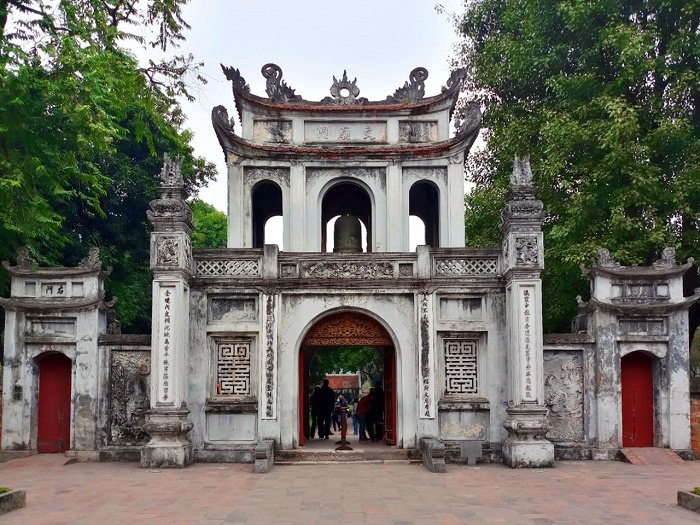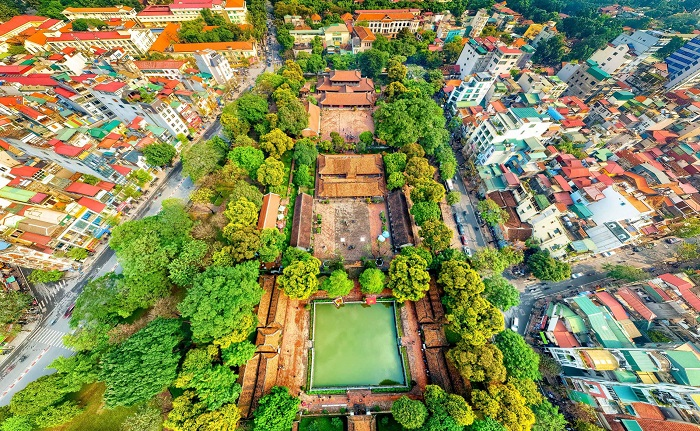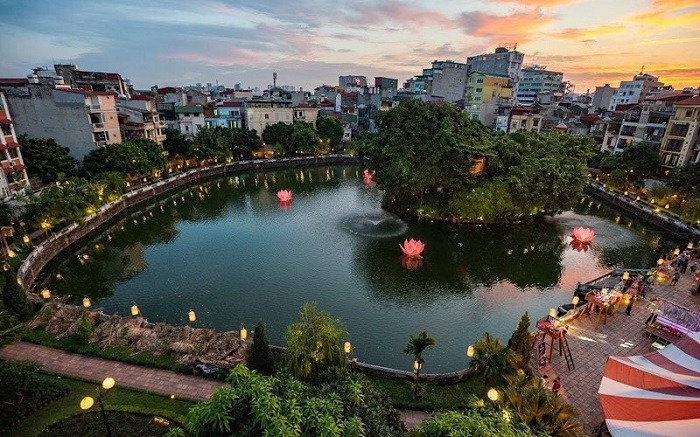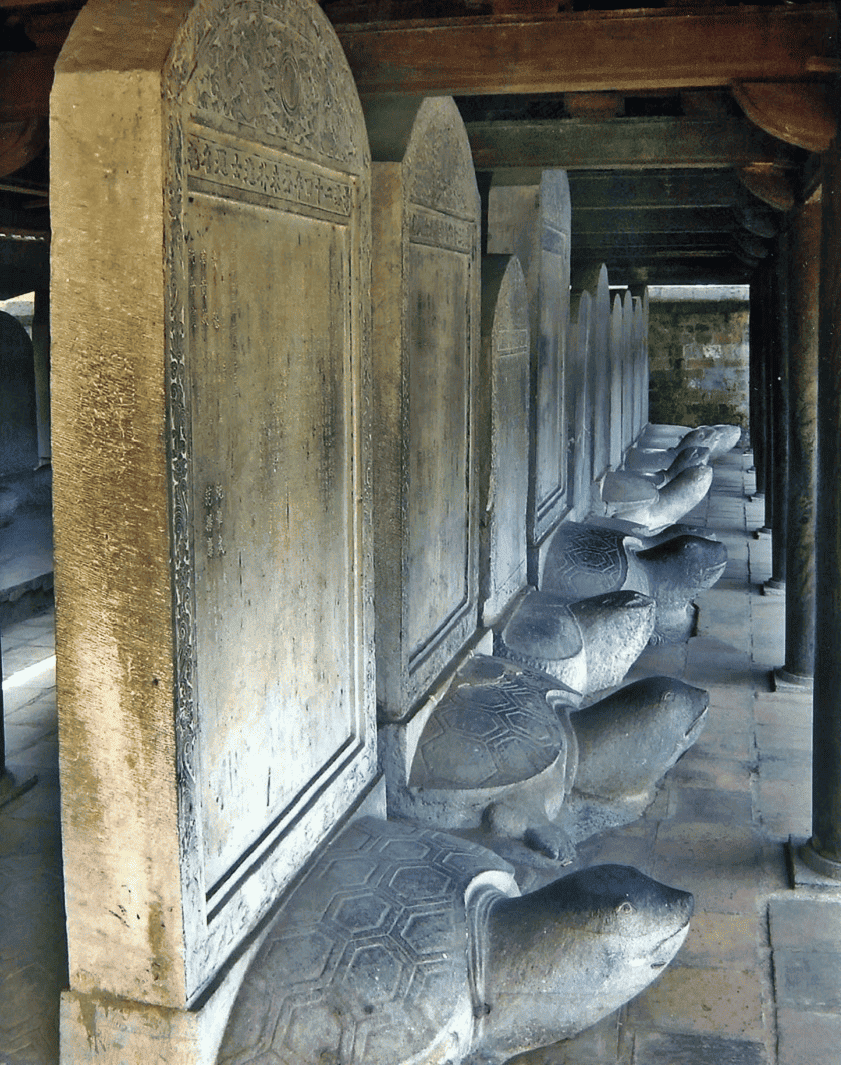Not only a famous cultural landmark, Van Mieu Quoc Tu Giam is also one of the most attractive tourist attractions when visiting Hanoi with its unique architecture and peaceful space, attracting thousands of tourists every year.
TABLE OF CONTENTS
1
1. Introduction to Temple of Literature
2
2. Where is Van Mieu Quoc Tu Giam's address?
3
3. Opening hours and ticket prices to visit the Temple of Literature
4
4. Learn the history of Temple of Literature
5
5. Architecture of the Temple of Literature, Hanoi
6
6. What is there to visit the Temple of Literature?
6.1. Gate of the Temple of Literature
6.2. Ho Giam
6.3. Dai Trung Mon - The Great Middle gate
6.4. Khue Van Cac - Constellation of Literature pavilion
6.5. Thien Quang Well - Well of Heavenly Clarity
6.6. 82 Stelae of Doctors
6.7. Dai Thanh Mon - Attained Talent gate
6.8. Dai Bai Duong
6.9. Khai Thanh Temple
7
7. Fascinating experiences when visiting the Temple of Literature
8
8. Experience visiting the Temple of Literature
Not only a famous cultural landmark, Van Mieu Quoc Tu Giam is also one of the most attractive tourist attractions when visiting Hanoi with its unique architecture and peaceful space, attracting thousands of tourists every year.
Built in the 10th century, the Temple of Literature - the first university in Vietnam has become one of the must-visit tourist attractions when visiting Hanoi. Here, visitors will learn about the history and cultural traditions of the Vietnamese nation and admire the unique beauty of architectural works.
%20(1).png)
1. Introduction to Temple of Literature
The Temple of Literature is one of the oldest and precious cultural heritages of the Vietnamese nation, which has attracted a large number of tourists to visit in the past year when visiting Hanoi.
Located in the south of Thang Long Citadel, the complex of Van Mieu Quoc Tu Giam relic is the place where unique architectures are concentrated such as Van lake, Giam garden and Temple of Literature (where Confucius is worshiped) - Quoc Tu Giam (school) Vietnam's first university). This is the place to worship the three wise kings of the nation: Ly Thanh Tong, Ly Nhan Tong and Le Thanh Tong.
The interior of the Temple of Literature is surrounded by brick walls and inside are 5 spaces with unique and separate architecture.
The Temple of Literature has been classified as a national relic and 82 doctorate steles have been recognized by UNESCO as "World Documentary Heritage".
Previously, the Temple of Literature - Quoc Tu Giam was the place to train thousands of talents for the country. Today, this place is a place to commend excellent students and at the same time, it is also the place where many traditional and folk activities take place to preserve and preserve traditional culture.

2. Where is Van Mieu Quoc Tu Giam's address?
Address: No. 58, Quoc Tu Giam Street, Dong Da District, Hanoi
Located in a prime location where the intersection of 4 central streets of Dong Da district are Nguyen Thai Hoc, Ton Duc Thang, Temple of Literature and Quoc Tu Giam and about 2-3 km from Hoan Kiem Lake. Therefore, visitors can easily move to Van Mieu Quoc Tu Giam in the following ways:
- Bus: if you use the bus, you can choose routes 02, 23, 38, 25, 41 to get off the nearest stop and then walk to the Temple of Literature
- Taxi, motorbike taxi: if you want to move quickly and conveniently, a taxi or motorbike taxi service is a good choice. With the popularity of taxi and motorbike taxi services in Hanoi, visitors can easily search and book a trip to visit and explore the Temple of Literature. However, to avoid encountering security risks and ensure reasonable prices, visitors should pay attention to choose reputable and reliable services.
- Double-decker bus: this is a fairly new vehicle, which has just appeared in recent years. Visiting the Temple of Literature and other famous sites and monuments of Hanoi by double-decker bus service, visitors will have extremely interesting experiences.
- Traveling by private vehicle: traveling by private vehicle will help you take the initiative in time as well as discover many other destinations on the tourist map of Hanoi. To find the most suitable route, avoid encountering one-way routes or traffic jams, visitors should learn and look up the map or ask the locals.
3. Opening hours and ticket prices to visit the Temple of Literature
- Opening hours: daily
- 7:30 – 17:30 (summer)
- 8:00 – 17:00 (winter)
- Entrance ticket price:
- Adults: 30,000VND
- Students, students: 15,000VND
- People with severe disabilities, the elderly: 15,000 VND
Note: With the ticket price per student, students need a student card, and for people with severe disabilities, the elderly need an ID card/CCCD and a Vietnamese citizen from 60 years of age or older.
4. Learn the history of Temple of Literature
If you only travel to Hanoi for 1 day, you can start your journey at the Temple of Literature to learn about the history and culture of the Vietnamese people.
The Temple of Literature (Temple of Literature) was built in 1070 during the reign of Emperor Ly Thanh Tong. Meanwhile, Quoc Tu Giam (Quoc Tu Giam) was founded by King Ly Nhan Tong in 1076 as a place only for the emperor's children and noble families.
In 1253, Quoc Tu Giam changed to the name Quoc Academy, which expanded and accepted the children of commoners with outstanding academic ability. During the reign of King Tran Minh Tong (1300-1357), Chu Van An was appointed to hold the position of a private Quoc Tu Giam official with the same role as the current principal, responsible for managing all activities of Quoc Tu Giam and directly taught the princes.
During that time, the Temple of Literature - Quoc Tu Giam became a training center for the country's leading intellectuals and a place to select the best talents to serve the court.
.png)
5. Architecture of the Temple of Literature, Hanoi
The complex of Van Mieu Quoc Tu Giam monuments bears bold early Nguyen architecture, located in a large rectangular area of 54,331m2 including many works with different unique architectures. The Temple of Literature campus is surrounded by 4 solidly built brick walls.
Experiencing the ups and downs of history and the process of remodeling, this relic now includes Ho Van, Temple of Literature, Dai Trung Mon, Khue Van Cac, Thien Quang well and stele of Doctor, Dai Thanh Mon and Thai Hoc house. .
This relic complex is designed according to the layout posted for each zone, each layer on the North-South axis. In front of the Temple of Literature is a large lake called Lake of Van, from the entrance to the large gate are four pillars, on the left and right sides there is a stele "Ha Ma" and around the area is surrounded by high walls.
The Temple of Literature is divided into 5 distinct areas separated by walls and to enter each interior area you will have to go through a door system including a main door and two side doors on either side.

6. What is there to visit the Temple of Literature?
6.1. Gate of the Temple of Literature
The Gate of Tam Quan Van Mieu Mon is the gate outside the Van Mieu Quoc Tu Giam relic site. Temple of Literature is built with three main doors, 2 floors are tall and the upper floor is engraved with 3 characters, which are Van Mieu Mon according to ancient Chinese characters and on top is the motif of two dragons adoring the moon, creating a unique and refined character for architectural works. In front of the Temple of Literature are the four pillars of Nghi Mon located in the middle, along with two Ha Ma steles on either side.
.png)
6.2. Ho Giam
Ho Giam, also known by another name, is Van lake or Duong Minh lake, located right in front of the gate of the Temple of Literature. According to history books, Lake Van is a large-scale construction with an area of up to ten thousand nine hundred meters. Located in the heart of Van lake is Kim Chau mound, on which is built Phan Thuy Duong. In the past, Phan Thuy Duong was a place to comment on poetry and literature of Confucian scholars.

6.3. Dai Trung Mon - The Great Middle gate
Through the gate of Temple of Literature, you will be greeted by an extremely beautiful, airy and majestic space at Dai Trung Mon.
Dai Trung Gate has the typical architecture of a Vietnamese traditional house, including 3 compartments covered with tiled roofs. On the top of the gate is a carp, which is said to represent students. Students have to study hard to pass exams just like a carp has to overcome big waves to become a great and powerful dragon.
6.4. Khue Van Cac - Constellation of Literature pavilion
Khue Van Cac was built in 1805 under the reign of King Gia Long, has impressed visitors by its very unique architecture.
Khue Van Cac is designed with a square floor of 8 roofs, nearly 9 meters high. The architecture consists of 4 square brick pillars below with sophisticated patterns, serving as a pedestal for the upper floor.
The upper floor with commentary is a "bright gem" of the Van Mieu Quoc Tu Giam relic, which is prominently designed with 4 windows shaped like a shining sun and a red tile roof with 2 layers to create a special roof construction. . On both sides of Khue Van Cac are two doors named Bi Van and Suc Van leading to each stele house of Dr. Van Mieu - Quoc Tu Giam.
.png)
6.5. Thien Quang Well - Well of Heavenly Clarity
Thien Quang well has a very special square shape and is surrounded by a corridor. According to the old concept, the square of Thien Quang well is meant to represent the earth and the round square on Khue Van Cac represents heaven. These two works represent all the quintessence of heaven and earth gathered at the largest cultural and educational center in Thang Long capital.
.png)
6.6. 82 Stelae of Doctors
Two rows of large stone steles, also known as Stelae of Doctors , are located on both sides of Thien Quang well. 82 Stelae of Doctors are placed on the backs of 82 bluestone turtles which are exquisitely sculpted with different styles and have great spiritual significance. And on these steles honor 82 valedictorians in the examinations of the ancient Vietnamese feudal dynasties.

6.7. Dai Thanh Mon - Attained Talent gate
Dai Thanh Mon has the same architecture as Dai Trung Mon, built in the style of the Late Le Dynasty with 3 compartments, each with a red painted door with dragon and rattan motifs and 2 rows of columns, front and back porches, 1 row of columns in the middle. . Above the roof border, in the middle hangs a horizontal painting engraved with 3 Chinese characters "Dai Thanh Mon" with the meaning of great success.
6.8. Dai Bai Duong
Visitors passing through Dai Thanh Mon and a large courtyard paved with Bat Trang bricks will come to the central area of Quoc Tu Giam, which is the dignified Dai Bai Duong shrine. Dai Bai Duong has 9 compartments, 2 gable walls on both sides. Among these compartments, only the middle one is used to place the altar of incense, the rest are empty. This shrine area is the place to hold ceremonies in the ancient spring and autumn festivals.
.png)
6.9. Khai Thanh Temple
Khai Thanh Temple is the last area of the relic. This is the place to worship Confucius's parents (Thuc Luong Ngot and Nhan Thi). Khai Thanh Temple was originally Quoc Tu Giam, a place for casting talents for many Vietnamese dynasties. But this place was destroyed by French cannon in 1946. After that, Khai Thanh Temple was rebuilt and is preserved to this day.
.png)
7. Fascinating experiences when visiting the Temple of Literature
Carrying with them important historical values and a long history of traditional culture, Van Mieu Quoc Tu Giam has become an attractive destination for domestic and international tourists. Here, visitors also experience extremely interesting and memorable activities:
- Visiting, learning about architecture, history or artifacts and documents at the Temple of Literature - a symbol of the country's studious tradition
- Take a photo with ao dai, bachelor's shirt or collar
- First letter of the year
- Burn incense to pray for good luck in studies and exams
- Attending the exhibition held at the Temple of Literature…
8. Experience visiting the Temple of Literature
To visit the Temple of Literature in the most perfect way, you should note a few things:
- Dress appropriately, politely and dignified
- Respect monuments, do not infringe on artifacts, documents or landscapes
- Don't rub the turtle's head and don't sit on the doctor's beer
- Comply with regulations on maintaining security and order at the Temple of Literature
- Only light 1 stick of incense and light it in the right place
- Do not bring food or drink into the Temple of Literature…
With a long cultural history and unique architectural works, Van Mieu Quoc Tu Giam is definitely an attractive sightseeing coordinate that visitors cannot ignore in their journey to discover the capital. This place is not only a valuable cultural heritage but also a treasure of knowledge and the quintessence of traditional education of the Vietnamese nation.










